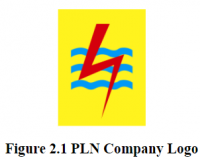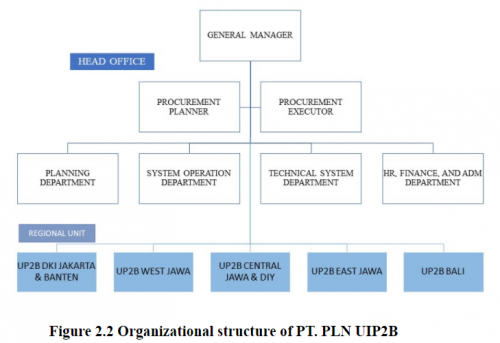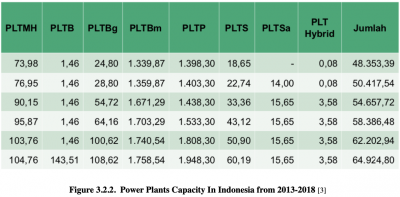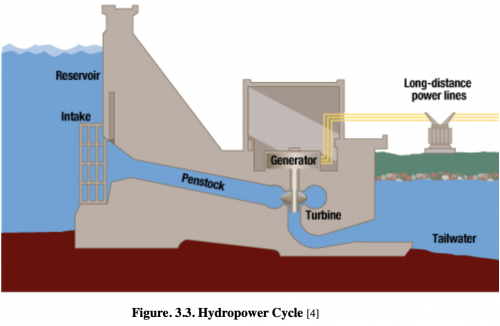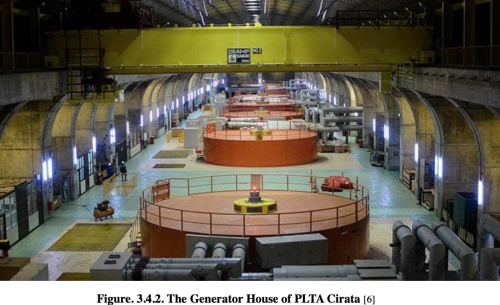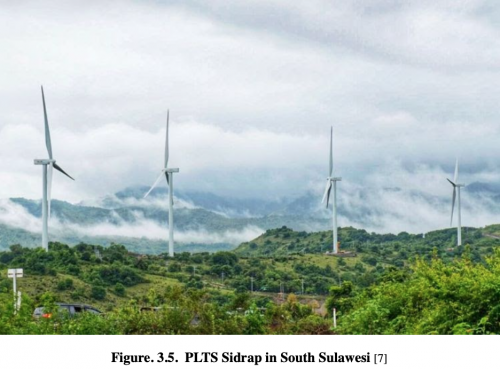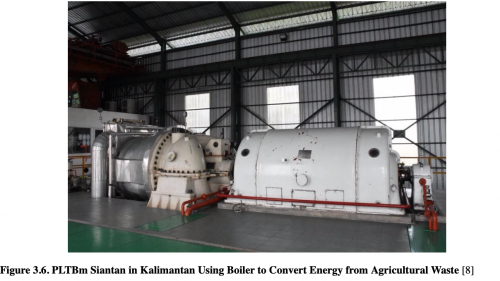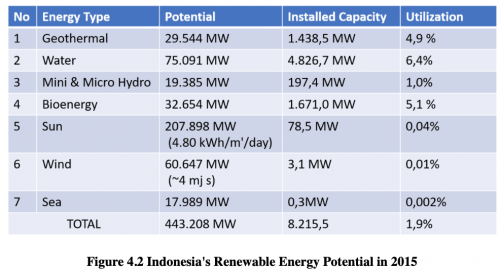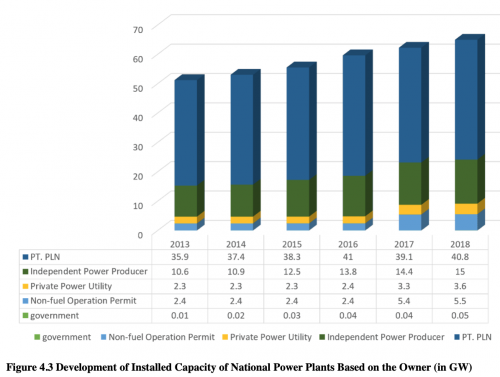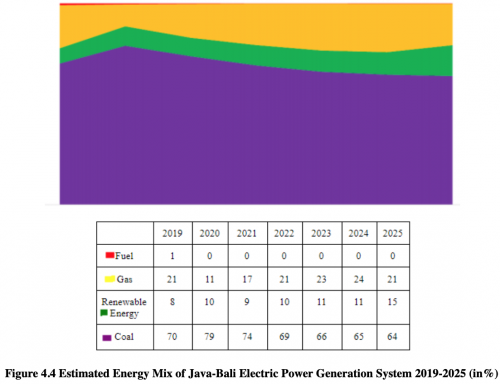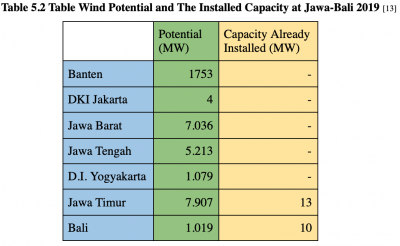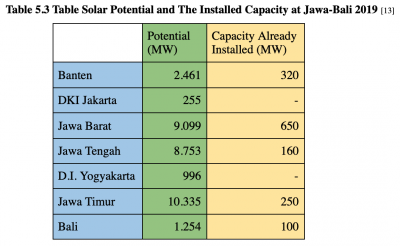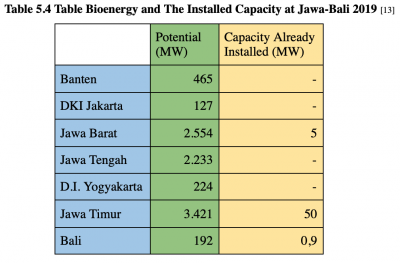ANALYSIS OF RENEWABLE-ENERGY SOURCES FOR ELECTRICITY GENERATION SYSTEM IN JAWA-BALI
Contents
[hide]TABLE OF CONTENT
CHAPTER I INTRODUCTION
- 1.1 Background
- 1.2 Report Objectives
- 1.3 Scope of the Report
- 1.4 Date and Place of the On Job Training
- 1.5 Report Outline
CHAPTER II COMPANY PROFILE
- 2.1 About PT. PLN (Persero)
- 2.1.1 Company Logo
- 2.1.2 Company's Vision and Mission
- 2.1.3 Company's Value
- 2.2 PT. PLN (Persero) UIP2B
CHAPTER III BASIC THEORY
- 3.1 Renewable Energy Definition
- 3.2 Renewable Energy Sources in Indonesia
- 3.2.1 Hydropower
- 3.2.2 Wind
- 3.2.3 Solar
- 3.2.4 Biofuel and Waste
- 3.3.Renewable Power Plant in Indonesia
- 3.3.1 PLTA (Pembangkit Listrik Tenaga Air)
- 3.3.2 PLTB (Pembangkit Listrik Tenaga Bayu)
- 3.3.1 PLTS (Pembangkit Listrik Tenaga Surya)
- 3.3.1 PLTBg (Pembangkit Listrik Tenaga Biogas)
- 3.3.1 PLTBm (Pembangkit Listrik Tenaga Biomassa)
CHAPTER IV DATA COMPILATION
- 4.1 2017 National Energy Plan (RUEN)
- 4.2 2019-2038 National Electricity Plan (RUKN)
- 4.3 2019-2029 Electricity Supply Business Plan (RUPTL)
- 4.4 2019 Java-Bali System Operation Evaluation (EOT 2019 PT. PLN UIP2B)
CHAPTER V DATA ANALYSIS
- 5.1 Data Analysis
CHAPTER VI CONCLUSION
- 6.1 Conclusions
- 6.2 Internship Result
REFERENCE
PPT LINK
CHAPTER I INTRODUCTION
1.1 Background
Renewable energy is an energy that comes from renewable resources, meaning that nature will naturally restock the resources by itself. For example renewable resources are sunlight, wind, rain, tides, waves, geothermal heat, and etc. There are already important energy sectors that use renewable energy resources to provide energy, one of them is the electricity power generation sector.
1.2. Report Objectives
The main objective is to provide a collection and summary about the data of PT.PLN UIP2B renewable-energy sources in the electricity generating system in Jawa-Bali. In addition, there are other objectives that are mainly for administrative purposes. They are as follows:
For the Internship Student
- To fulfill the requirement of Bachelor’s Degree in the University of Indonesia
- To add the insight and get an experience of the work-life in engineering field
- To study and be familiar about Renewable-Energy.
- To oversee the link and match between the practical work and the theoretical work
For the Company (PT. PLN UIP2B) in this case
- To create a good relationship with the education institutes.
- To improve the productivity of the company by having interns.
- To prepare for the next generation of engineers who understand about Renewable-Energy sources for electricity generating systems.
1.3. Scope of the Report
This report provides a collection and summary of PT. PLN UIP2B renewable-energy sources for electricity generating systems. The report will include data from the 2019-2029 Electricity Supply Business Plan (RUPTL), PT PLN (Persero), 2017 National Energy Plan (RUEN), Ministry of Energy and Mineral Resources (ESDM), 2019-2038 National Electricity Plan (RUKN), Ministry of Energy and Mineral Resources (ESDM), and also from the 2019 year evaluation report from PT. PLN UIP2B.
1.4 Internship Time and Location
The internship was conducted in PT. PLN (Persero) Unit Induk Pusat Pengatur Beban (UIP2B) Jl. JCC, Gandul , Cinere, Kota Depok, Jawa Barat. The duration of the internship is from August 3rd 2020 to September 30th 2020. However, due to the COVID-19 pandemic, the internship was mainly conducted as a work from home project with zoom call meetings and discussion at usual working hours from monday to friday.
1.5 Report Structure
The structure of this report is to follow the standard of the internship report set by the University. Chapter One : Provides the introduction of the work. It includes the background and the objective of the report. Chapter Two : Overviews the company profile -- PT. PLN UIP2B. Chapter Three : Gives the basic theories about renewable energy and renewable energy power plants. Chapter Four : Provides the collected data. Chapter Five : Provides the Analysis of the data and the comparison between the renewable energy power plants to non renewable energy power plants. Chapter Six : Conclusions and internship results are stated in.
CHAPTER II COMPANY PROFILE
2.1 About PT. PLN (Persero)
PT. PLN (Persero) is a state-owned enterprise that fully manages Indonesia’s electrical power field. On October 27th, 1945, Indonesia’s then president, President Soekarno established the Electricity and Gas Bureau under the Department of Public Works and Energy. However, on January 1st, 1961, the Electricity and Gas Bureau was changed to BPU-PLN (General Chairman of the State Electric Company) engaged in electricity, gas and coke. But, exactly 4 years later BPU-PLN was dissolved. At the time of the dissolvement of BPU-PLN, 2 (two) new companies were inaugurated, namely the National Electricity Company (PLN) to manage electricity and the State Gas Company (PGN) as the gas manager. And up to this day, PT PLN is the only company that sells electrical services in Indonesia. PT. PLN divided the company into units, the Main Office (Kantor Pusat), the Main Units and/or Centers (Unit Induk dan/atau Pusat-Pusat), the Executor Units (Unit Pelaksana), and the Service Units (Unit Pelayanan).
2.1.1 Company Logo
Meaning of the elements in the company logo:
- Lightning
Symbolizes electric power as the main product of the company. It also means fast and accurate work by the employees of PT. PLN in giving the finest solution towards the consumer. Red on the lightning represents sophistication of the company being the first electric energy corporation in Indonesia, also reflects tenacity in working and courage to push forward technology development.
- Three Waves
Represents electric energy flow from the three main aspects the company works on: Generation, transmission, and distribution. The color blue shows the impression of consistency being in the life of the community and also it represents reliability.
- Yellow Vertical Rectangle
Being the base of the symbol, it shows how PT. PLN is a well-organized corporate and field. The color yellow symbolizes enlightenment, as how the company enlightens the community. It also symbolizes the fiery spirit that is within the people of the company.
2.1.2 Company’s Vision and Mission
Vision
- Recognized as a world-class company that grows, superior and trusted while resting on human potential.
Mission
- Runs electricity business and other related fields, oriented towards customer satisfaction, member of company and shareholder.
- Makes electricity as a media to improve society’s life quality.
- Strive for electricity to be the driving force of economic activity.
- Runs an environmental-friendly company.
2.1.3 Company's Values
- Mutual Trust
Atmosphere of appreciation and open between company members that is based on trust and integrity, good faith, and competence from parties that are interconnected in conducting clean and ethical business practice.
- Integrity
Form of company members’ attitude that consistently shows honesty, harmony between words and deeds, and responsibility towards company management and company resources utilization for good cause in short or long term, and responsibility towards all related parties.
- Care
Reflection of the will to keep and maintain work quality in company, with awareness of every problem faced by the company and finding the right solution.
- Studious
The act of company units to always question system and development practices, management and operation, and attempt to dominate science and technology development for the sake of continuous company renewal.
- Aware of customer needs
Always strive to satisfy customers and fulfill their needs fast, correctly and accordingly.
- Appreciation towards human dignity
Values highly human dignity with all its advantages and disadvantages and recognizes and protects human rights in running business.
- Integrity
Values honesty, integrity, and objectivity in managing business.
- Product quality
Improve quality of product continuously and measured also keeping environment quality in running the company.
- Opportunity to improve
Giving the same opportunity to every company unit to gain achievements and occupy positions accordingly with the criteria.
- Innovative
Ready to share knowledge and experience with company units, growing curiosity and appreciating ideas and innovations.
- Prioritize company interests
Consistent in preventing conflict of interests and guarantee every decision is addressed to company interests.
- Shareholder
Business decision making will be oriented towards improving shareholder investment value.
2.2 PT. PLN (Persero) UIP2B
PT. PLN UIP2B or Unit Induk Pusat Pengatur Beban is one of the main units under PT. PLN that manages the load regulation in jawa-bali. In this PLN unit, they carry out electric power system operations and manage the distribution of high voltage electric power. The UIP2B is a unit of PLN as an extension of the head office for electricity services at PLN, as well as an institution at PLN as support for PLN's electricity business in the region. In short, this unit does the load regulating and the operation system of the main 500kV power plants and 500kv substation in Jawa-Bali. Also together with the regional unit, this unit manages and regulates the small-scale local generation systems connected to 150 kV, 70 kV and 30 kV systems and the transmission systems. The UIP2B unit divided according to its function, for example, PLN West Java Distribution Main Unit which is located in Bandung as a distribution service in West Java Province, or PLN Central Java Transmission Main Unit as electricity transmission service in West Java and Yogyakarta Central Java provinces. Meanwhile, the mains are PLN institutions that support PLN's business, for example, the PLN Education and Training Center (PUSDIKLAT), which is an institution for the development and training of PLN employees, as well as other centers. The parent unit and centers led by a General Manager of the Main Unit or General Manager of the Center.
The interns are being placed in the planning department under the System Operational Planning. System Operation Planning is the division where planning of the operation of an electric power system takes place which includes distribution planning and generation planning to achieve the target of an economical, reliable and quality electric power system operation.
CHAPTER III BASIC THEORY
3.1. Renewable Energy Definition
Based on IEA (International Energy Association), renewable energy resources are derived from natural processes and replenished faster than they are consumed. Based on EIA, renewable energy could also be defined as energy from naturally replenishing sources but flow-limited.
3.2. Renewable Energy Sources in Indonesia
Based on IEA, Indonesia's major energy resources are coal, natural gas, biofuel, waste, wind, solar, and hydro. While from the major energy resources in Indonesia, few renewable energies are hydro, wind, solar, natural gas, biofuels, and waste.
3.2.1. Hydropower
Hydropower produces energy through the power of moving water. Hydropower produces electrical energy by moving turbines with water movements. While generating electric energy through the power from moving water, hydropower has four common typologies: run-of-river hydropower, storage hydropower, pumped storage hydropower, and offshore hydropower.
Run-of-river hydropower is a facility that generates energy by using water flow from a river through a canal. The water flow then will spin a turbine. Run-of-river hydropower provides a daily supply of electricity.
Storage hydropower is a large system where it uses dams to save water in reservoirs. The system generates energy by releasing the water inside the reservoir through a turbine. By doing this, the turbine will activate the generator; hence it generates energy. Pumped storage hydropower generates energy by using upper and lower reservoirs pumped so the water will always stay in the cycle. Offshore hydropower generates energy by using the power of waves from seawater or tidal currents.
3.2.2. Wind
Wind produces energy from the air in motion that creates kinetic energy. The kinetic energy then will be converted into electrical energy by a wind turbine or wind conversion machine. The wind hits the turbine that causes the turbine’s blade to move (rotate); therefore, the kinetic energy changes into the blade's rotational energy, moving the shaft that is being connected to the generator. Thus the generator produces energy.
3.2.3. Solar
Solar produces energy by converting the sunlight energy into electricity with solar cells or Photovoltaic (PV). Solar panels also benefit from having a long lifespan, 30 years, and produced in a variety of sizes and types. Solar could also convert the sunlight energy with another device called concentrated solar power (CSP). CSP generates electricity by concentrating solar rays into mirrors. The concentrated solar rays will produce rays that heat a fluid that creates steam to drive the turbine, and the turbine generates electricity.
3.2.4. Biofuel and Waste
Biofuel and waste are divided into traditional and modern waste. Traditional waste derives from animal waste, traditional charcoal, wood from forests, and agricultural waste. Modern waste energy sources derive from product waste, residues, and technologies such as bio-refineries and wood pellet heating systems.
3.3. Renewable Power Plant in Indonesia
Indonesia has built a lot of power plants with renewable energy as the energy sources. In 2018, Indonesia has the capacity of 9.781 MW for its renewable power plant and by 2019, the renewable power plant’s capacity reached 10.000 MW.
3.3.1. PLTA (Pembangkit Listrik Tenaga Air)
Hydropower technology is one of the renewable power plants in Indonesia. Hydropower has a dam to keep water in the human-made lake. When the dam's water is released, it will create potential energy that will move the turbine. The turbine is connected to a generator that will generate electricity. Then the water will return back to the dam, and the cycle keeps going on.
Hydropower technology is one of Indonesia's most significant power plants after natural gas and the most significant renewable power plant in Indonesia. The biggest of Indonesia's hydropower sites in Indonesia is Cirata Hydropower in Bandung, West Java. Cirata Hydropower has been operating commercially since 1988 with four units. Cirata Hydropower has a capacity of 1.0008 MW.
3.3.2. PLTB (Pembangkit Listrik Tenaga Bayu)
Wind power technology in Indonesia uses the Horizontal-Axis turbine type. The turbine will be built 30 meters or more above the ground. Building a tower wind turbine tall above the ground will allow the turbine to generate more kinetic energy with faster wind speeds above. Horizontal-Axis turbines commonly use two until three propeller-like blades connected to a rotor. When turbines catch energy from the wind, low-pressure air will move the blade. This will cause the blade to turn the rotor; the lift. The force from the lift will cause a drag where the force is stronger than the wind’s force. The combination of drag and lift makes the rotor spin.
Indonesia has two wind power stations that still operate until this day; PLTB Sidrap in Watang Pulu, South Sulawesi and PLTB Tolo 1 Jeneponto in Binamu, South Sulawesi. These wind powers have operated since 2018 with the capacity of 75MW at PLTB Sidrap and 72MW at PLTB Tolo 1 Jeneponto.
3.3.3. PLTS (Pembangkit Listrik Tenaga Surya)
PLTS in Indonesia uses photovoltaic type as the power generator. PV (Photovoltaic) will convert sunlight to power (electricity). Photons from the sunlight hit the PV panels material, where the free electrons are being generated. The photons go through the material and will produce an electrical DC (direct current). The DC will convert into AC with an inverter then it will be used for an electrical grid. PV panels only work as a converter of energy, transmitting the energy to where it is needed.
Indonesia has 24 solar power plants with 22 solar power plants that still operate until this day. Two solar power plants that stopped operating are located in Bali due to failing on maintenance. Meanwhile, one of the solar power plants that still operates is located in Purwakarta, West Java, named PLTS Cirata, with a capacity of 1 MW. PLTS Cirata is located at the same place as PLTA Cirata, the biggest hydropower in Indonesia. Its photovoltaic systems are installed to float above the water dam.
3.3.4. PLTBg (Pembangkit Listrik Tenaga Biogas)
PTLBg uses organic waste that went through a process namely anaerobic digestion. It is a process to break down the organic material from the bacteria in an oxygen-free environment. Recycling the original material then turning it to biogas, containing energy in gas form and soil products (in solid and liquid forms).
In 2017, Indonesia has a PLTBg from a private company at Libo, Riau. The power plant was built and used for personal purpose (Kernel Crushing Plant Factory), yet the private PLTBg still has another 0,5MW left unused. In 2018, PT PLN (Persero) also signed a 2-year contract with a private company that owns the power plant at Central Kalimantan. This contract allows PT PLN (Persero) to improve the renewable energy usage in South Kalimantan and Central Kalimantan until 8,8 MW. Based on the table for the energy plant capacity, PLTBg has a significant increase with 20,48 in 2014 into 108,62 in 2018.
3.3.5. PLTBm (Pembangkit Listrik Tenaga Biomassa)
PLTBm uses boiler gasification to convert energy from organic waste into renewable energy sources such as electricity. Organic waste will be treated at a high temperature, above 700 Celcius, without the combustion process. The high-temperature conversion will also be controlled by oxygen and steam into hydrogen, carbon dioxide, and carbon monoxide. The carbon monoxide will react with water to form carbon dioxide and hydrogen in the water-gas shift reaction. Then the special membranes will separate the hydrogen from the gas stream.
In 2018, Indonesia, with a private company, built PLTBm Siantan in Wajok Hulu village, Kalimantan. The biomass power plant uses gasification technology where the boiler will generate energy by consuming rice husk, bagasse, and agricultural waste as its fuel. This PLTBm has a capacity of 75.00 kWh, equal to 25.000 Ton CO2e. In 2019, Indonesia built a PLTBm in Siberut Island, Mentawai. This power plant uses bamboo as the energy sources combine with forest residue. With a total capacity of 700KW, this PLTBm could light up three villages in Mentawai.
CHAPTER IV DATA COMPILATION
4.1. 2017 National Energy Plan (RUEN)
The 2017 National Energy General Plan (RUEN) is the mandate of the Law (UU) No. 30/2007 on Energy. Based on the mandate of Article 17 paragraph (1) of the Law, the Government prepares a RUEN Draft based on the National Energy Policy (KEN) and Article 12 paragraph (2) letter b mandates that the National Energy Council (DEN) has the task of arranging the RUEN.
RUEN is a guideline for national energy management to create energy independence and national energy security in support of sustainable national development. In this general plan that has been approved by the President of Indonesia, states the current energy issues and problems and a few of them is about renewable-energy. It writes that in Indonesia renewable-energy prices are not yet competitive and energy subsidies are not on target. Basically, it means that apart from the fact that most of the renewable energy technologies are still expensive, renewable-energy prices are not yet competitive due to subsidies for fuel and electricity that uses fossil energy. As a result, renewable-energy cannot compete with fossil energy.
Another problem that is written in this RUEN is the fact that utilization of renewable energy in Indonesia is still low. The potential for renewable energy such as geothermal, water, bioenergy, solar and wind or wind is very abundant in Indonesia. Indonesia's forest area of 120 million hectares has huge potential sources of biomass, water energy and geothermal energy. However, In 2015 the share of renewable energy in the national energy mix in the electricity sector was still low, around 10.5% of total production. Mostly the energy used in generating electricity is coal with 56.1%, followed by natural gas at 24.9% and fuel at 8.6%
Utilization of renewable energy has only reached about 2% of the total potential of existing renewable energy. This potential is the basis for a renewable energy development plan for at least 23% of the total primary energy mix in 2025 and at least 31% of the total primary energy mix in 2050.
4.2. 2019-2038 National Electricity Plan (RUKN)
The 2019-2038 National Electricity Plan (RUKN) contains national electricity policy, direction of development of electricity supply, current conditions of electricity supply, and projection of electricity demand for the next 20 years. One of the directions of developing electricity supply in the field of generation includes renewable energy as the sources at a minimum of 23% out of all energy sources by 2025. The use of primary energy for power plants as regulated in Article 6 of Law Number 30 of 2009 concerning Electricity is carried out in accordance with the National Energy Policy (KEN) as outlined in Government Regulation Number 79 of 2014 concerning National Energy Policy. Through this government regulation, the Government is targeting the share of new energy and renewable energy to continue to increase to at least 23% by 2025 as long as the economic value is met.
Stated that in 2025 it is targeted that the mix of renewable energy is at least 23%, gas around 22%, coal around 55%, and fuel at around 0.4%. Meanwhile in 2038, it is targeted that the mix of renewable energy is at least 28%, gas is around 25%, coal is around 47%, and fuel is around 0.1%. The energy mix target applies to PT PLN (Persero).
The geothermal potential in Java and Bali is expected to be immediately utilized as geothermal power plants, because the largest portion of national electricity consumption is in the Jawa-Bali system, so that the electricity supply provided can be absorbed and utilized. As for the development of new steam power plants in Java Island, at least in the next 10 years it is limited to Steam Power Plant projects that have entered the construction phase or have contracted and received price approval from the Minister.
The condition of electricity supply in Jawa Island includes the condition of the electric power system in all provinces in Java and Bali that written in this general plan are:
- The total installed capacity of power plants in 2018 is around 40,510 MW consisting of:
- PT PLN (Persero) plants of around 26,937 MW,
- Independent Power Producer around 10,495 MW,
- Private Power Utility around 2,546 MW,
- Government around 3 MW
- Non-Fuel Operation Permit of around 528 MW
- The total length of the transmission network is around 23,550 kms
- The substation is around 1,206 units with a total capacity of around 98,863 MVA.
- The total length of the electric power distribution network is 499,960 km
- The distribution substations are 285,651 units with a total capacity of 36,599 MVA.
- The electricity consumption, including consumption outside PT PLN (Persero) 's business area, reaches around 185 TWh.
The installed capacity of the national power plant has increased by an average of about 4.9% per year over the past 5 years. When viewed per year, generating capacity grew by around 3.5% in 2014, 4.6% in 2015, 7.4% in 2016, 4.3% in 2017, and 4.4% in 2018. At first glance, the increase in total generating capacity seems relatively large but the distribution is not proportional, where the regions in Java and Bali have sufficient supply while some areas outside Java Bali experience limitations. The growth can be seen in the graph below:
The optimal energy mix for electricity generation in the Java-Bali System in 2019 in order to achieve the energy mix target for national electric power generation consists of coal around 70.1%, gas around 21.4%, renewable energy around 7.6%, and fuel about 0.9%. In 2025, the energy mix for electricity generation in the Java-Bali System will consist of coal around 63.9%, gas around 20.6%, renewable energy about 15.3%, and fuel around 0.2%. The estimated energy mix of the Java-Bali system in 2019-2025 are:
With this target of the energy mix for electricity generation, the cumulative additional composition of power plants by 2025 consists of:
- Steam / Mine-Mouth power plants (PLTU/MT) of around 11,386 MW
- Gas / Gas-Steam / Oil-Gas power plants (PLTG/GU/MG) of around 14,265 MW
- Water / Minihidro & Solar power plants(PLTA/M & PS) around 3,507 MW
- Geothermal Power Plant (PLTP) around 565 MW
- Diesel Power Plant (PLTD) around 100 MW
- Other renewable energy power plants are around 2,424 MW. Other renewable energy power plants consist of VRE around 1,500 MW and Bio-fired Power *Plants of around 924 MW.
4.3. 2019-2029 Electricity Supply Business Plan (RUPTL)
RUPTL is a guideline for the development of electric power systems in the PLN business area for the next ten years. According to RUPTL, the development of generating capacity is intended to increase the reliability of the desired supply, by prioritizing the use of local energy sources, especially renewable energy. Utilization of renewable energy such as geothermal, wind, solar, biomass, waste and hydropower is encouraged but still considering price efficiency in order to reduce the basic cost of providing electricity.
The RUPTL also contains PLN's plans for implementing PV rooftop. Solar power plant / PV rooftop is one of the developments of a distributed electricity system where the use of solar energy can be done and generally parallel with the electrical system of the related utility. The sun is a renewable energy source with abundance and relatively evenly distributed throughout Indonesia. In the regulation of the Minister of Energy and Mineral Resources number 49 of 2018 concerning the use of systems to build PV rooftops, it opens opportunities for PLN customers to build PV rooftops on the roofs of their buildings.
PLN's strategic initiatives in ensuring adequate supply and increasing the energy mix of future renewable energy generators at an optimal price for electricity from renewable energy generators a few of them are as follows:
- To develop renewable energy generators while still paying attention to supply-demand, electricity system readiness and economics.
- Utilizing renewable energy sources both from the type of water flow and waterfall energy, geothermal energy (including small scale), biofuels, wind energy, solar energy, biomass, waste and others as well as supporting RE-BID (renewable energy based on industrial development).
- Developing microgrids by applying scattered or centered PV, wind generation, or pico-hydro for isolated areas / remote communities far from the grid in disadvantaged areas, and other outer islands in accordance with the available energy potential.
- Prepare sufficient knowledge, talent, and business schemes to catalyze the implementation of concentrated solar panels or floating solar panels, wind power generation and biomass based power generation, as well as the development of waste material-based generators.
- Prioritizing solar hybrid power generation with diesel power generation for low-on hour areas (under 12 hours / day) usually in eastern Indonesia
- Increasing adequate capacity starting from the planning side to the operation of existing systems for renewable energy generation installations by considering a comprehensive evaluation of potential disruptions.
Based on data from the Handbook of Energy and Economic Statistics of Indonesia 2017 published by the Ministry of Energy and Mineral Resources, the total geothermal potential is 28,579 MWe consisting of 11,073 MWe of resources and 17,506 MWe of reserves. The potential energy scattered in Java Island itself is 1,410 MWe for speculative resources, 1,689 MWe for hypothetical resources, while for the estimated reserves it reaches 3,949 MWe, the possible reserves are 1,373 MWe and proven reserves are 1,865 MWe. with the total potential energy of the island of Java is 10,286 MWe with installed capacity is 452 MWe. Meanwhile, the potential energy on the island of Bali is 70 MWe for its cumulative resources, and the hypothetical resource is 22 MWe. whereas for the potential energy reserves that are expected to be 122 MWE, possible reserves of 110 MWe and proven reserves of 30 MWe, the total potential energy for the island of Bali is 354 MWe and its installed capacity in Bali Island is 0.
According to a study and screening in 2011 the potential for hydropower in Indonesia was 26,321 MW in total, consisting of 4,338 MW of projects already operating, 5,956 MW of projects already planned and under construction, and 16,027 MW of new potential.However, for mini and micro hydro power plants there are several things that become obstacles in the development, among others, there are overlapping permits in one watershed and difficulties for developers to get funding. The solution to solving these problems is through efforts to improve the licensing database system at the central or regional government that is swimming and improve the feasibility study document and the power purchase agreement document to make it more bankable. Meanwhile for solar power plants there is a solar power plant program called 1000 islands or locations, namely a solar energy development program with photovoltaic technology by PLN prepared through the solar power plant development program on locations or islands that have problems with expansion or network access and difficulties transportation.
The government encourages the use of energy derived from municipal waste with the main objective of solving waste problems in cities experiencing sampeh emergencies by using the following types of technology:
- thermal treatment technology (Grate, fluidized bed, direct melting, gasification and plasma gasification
- non thermal treatment (wet AD and dry AD)
The potential for wind energy in Indonesia has been identified in several locations in the regions of Sumatra, Java, South Sulawesi, Southeast Nusa and Maluku. A wind power plant is a generator with intermittent energy sources, producing fluctuating amounts of electrical energy. In its operation, a backup generator is needed as a support generator to anticipate a decrease in wind speed below the turbine design limit. so that for each region with different system characteristics, a different study is also needed to assess the feasibility of a wind power generation project, especially large-scale.
The development of power plants using marine energy is still in the research stage. Until now, there is no technology manufacturer for the conversion of marine energy into electricity with proven reliability to operate commercially for 5 years. PLN will consider developing marine energy when the technology is mature and commercially available. Attractive marine energy is the energy of ocean currents and tides, which is more accurate to predict the potential of available energy.
Indonesia is the largest crude palm oil producer in the world, and its production is increasing so that the potential utilization of CPO, which consists of BBM B20 and pure CPO, can be used as fuel for power plants.
In the period 2019-2028, in Java, Bali, Southeast Nusa the plan for energy production from fuel will decrease, energy production from coal increases by 1.5 times, gas increases 1.6 times and renewable energy increases 3.7 times. This reflects that the planning in the RUPTL is in line with the government policy regarding energy diversification, namely reducing fuel consumption, optimizing the use of coal and gas and increasing the share of renewable energy.
4.4. 2019 Java- Bali System Operation Evaluation (EOT 2019 PT. PLN UIP2B)
The 2019 Java Bali System Operation Evaluation is the realization of the operation of the Java Bali electric power system for the 2019 period.
The contribution of production from generating units for the type of renewable energy is as follows:
- Geothermal energy is generated by PLTP Kamojang 1-3, PLTP Kamojang 4-5, PLTP Drajat 1, PLTP Darajat CGI 2-3, PLTP Gunung Salak 1-3, PLTP Gunung Salak DSPL 4-6, PLTP Wayang Windu 1-2, PLTP Dieng, PLTP Patuha, and PLTP Karaha Bodas.
- Water energy is generated by PLTA Saguling, Sutami, Cirata, Jatiluhur, Brantas, Mrica, small-scale PLTA owned by PJB and IP which are spread in UP2B I to UP2B IV and PLTA Rajamandala which is COD on May 12, 2019
CHAPTER V DATA ANALYSIS
5.1. Data Analysis
Based on the compiled data, the Government is targeting the share of new energy and renewable energy as the primary energy for power plants to continue to increase to at least 23% by 2025. Even though the potential of renewable energy reaches around 443.208 MW in Indonesia, only 2% of it is being utilized right now. Meanwhile, for the Jawa - Bali system itself the optimal energy mix in order to achieve the energy mix target for national electric power generation should consist of coal around 70.1%, gas around 21.4%, renewable energy around 7.6%, and fuel about 0.9%. Also In the period 2019-2028, in Java, Bali, Southeast Nusa the plan for energy production from fuel will decrease, energy production from coal increases by 1.5 times, gas increases 1.6 times and renewable energy increases 3.7 times.
The realization of these plans is what matters. In the 2019 EOT Java-Bali system it is written that the renewable energy that is used in Java-Bali system was 7.71% from the overall energy mix which exceeds the target of 7.6% of renewable energy. However only hydropower and geothermal that has been used in Jawa - Bali system. There are several other renewable energy potentials that can be utilized such as wind power and biomass.
5.2 Renewable Energy Potential in Jawa-Bali
To analyze the renewable energy potential in Indonesia focusing more on Jawa-Bali, the renewable energy data from Institute for Essential Service Reform was also added.
5.2.1 Hydropower
As it can be seen on the table 5.1, 4 out of 7 locations in Jawa-Bali have the potential to build hydropower energy. Based on the locations where the energy potential exists, it can be concluded that hydropower energy which uses hydro as the energy generator is available in places with plateaus or high land. The plateaus or high land usually has an upstream, hence these places have the potential to generate energy with hydropower. Meanwhile non-hydropower potential locations such as Banten, DKI Jakarta, and D.I. Yogyakarta are located in a lowland that has an even ground level, hence these places don’t have the hydropower energy due to not having any direct contact to generate power from the upstream to downstream.
As for the implementation, from the hydropower places that have used its own capacity to the fullest, Jawa Barat with the highest hydropower potential has used almost half of its potential. Meanwhile Bali with the lowest hydropower potential amongst the other 4 still hasn’t been implemented.
5.2.2 Wind
As it can be seen on table 5.2 almost every place in Jawa and also Bali has big potential for wind energy. The amount of wind energy potential in every place varies due to their locations and the layout of each place. All these places have wind power potentials, but also the capacity that has been installed is still a minus. Generating power from the wind is also difficult to do, due to places in Indonesia having low wind speed.
Every place in Jawa has the potential to generate wind energy but based on the data there hasn’t been a lot of wind energy installation, there are even places where there’s no wind energy generator being installed. This happened also due to the lack of land availability in a lot of these places to build a wind. Based on KESDM, 2016 central java and Yogyakarta have intermediate to low resources potential with wind speed from 5.0-3 m/s at 50 m and wind power density 150-75 W/m2 or lower. The wind power density for Central Java and Yogyakarta prevent these places from installing a wind power generator even though the potentials are high.
Jawa Timur and Bali have an intermediate resources potential based on the same data source. With wind speed from 5.0-4.1 m/s at 50 m and with wind power density from 150-75 W/m2. While Banten, DKI Jakarta, and Jawa Tengah have good resources potential with the wind speed above 5 m/s at 50 m and with wind power density more than 150 W/m2 at. Though Banten, DKI Jakarta, and Jawa Tengah have the highest resources potential, the lack of empty land to build the wind installation makes the potentials are being wasted away.
5.2.3 Solar
All locations in Jawa and Bali have the potential to generate solar power as their renewable energy. DKI Jakarta with the lowest potential capacity in 255 MW, then followed by D.I. Yogyakarta 996 MW and both of these locations are the only places in Jawa-Bali that still haven’t installed any solar installation from the government yet based on the 2019 data. This happened also with the same reason, due to the need of land to build a big solar panel installation. While in another locations at Jawa has installed the solar power, though only 2-7% from the potential that each locations has been installed.
5.2.4 Bioenergy (Biogas and Biomass)
Jawa and Bali have a relatively small amount of bioenergy potential from 3.421 MW in Jawa Timur and the lowest amount 127 MW in DKI Jakarta. Bali, Jawa Barat and Jawa Timur are by far the only few locations in Jawa-Bali that installed bioenergy power generations. Bali has installed 0,9 MW from its total bioenergy potential of 192 MW. Jawa Barat has installed approximately 5 MW bioenergy power from the potential that it has as much as 2.554 MW. While Jawa Timur has installed 50 MW from its location potential 3.421 MW.
Biogas and biomass energy requires a sustainable and reliable supply of feedstock. Strong agriculture sector that the residue can be used as feedstock for power generations. Indonesia built PLTBm and PLTBg 10 MW in Kalimantan Tengah and Kalimantan Selatan [16]. Kalimantan has big free land hence it is easy to build bioenergy power generators. PLTBm using wood as its feedstock will be built in Kalimantan Tengah. Meanwhile PLTBg using palm residues as its feedstock will be built in Kalimantan Selatan. Investors also need to create a long-term contract with the local feedstock supplier to generate the power non-stop [17]. Feedstock price could fluctuate significantly and this might become a challenge because the supplier may not want to sell the feedstock with the initial price from the first contract.
5.3 Comparisons between Renewable Energy and Non-Renewable Energy Power Plants
There are a lot of pros and cons of each power plant. In Indonesia renewable-energy prices are not yet competitive compared to fossil energy and energy subsidies are not on target. Basically, it means that apart from the fact that most of the renewable energy technologies are still expensive, renewable-energy prices are not yet competitive due to subsidies for fuel and electricity that uses fossil energy. As a result, renewable-energy cannot compete with fossil energy. Another problem is that Indonesia still lacks experts in renewable energy, so the development of the renewable energy power plant is not as advanced as the fossil power plants.
CHAPTER VI CONCLUSIONS
6.1. Conclusions
Based on this Internship report, the authors can conclude that :
- Renewable energy is derived from natural processes and replenished faster than they are consumed.
- Indonesia has a diverse and abundant renewable energy potential. For example, geothermal, wind, hydropower, biogas, and biomass. All renewable energy still hasn't been utilized to the fullest, with hydropower leading amongst Indonesia's renewable energy sources.
- The renewable power plants in Jawa-Bali are still lacking compared to the other region in Indonesia due to the geographic potential that does not support the power plant.
- Indonesia sets a target for 2025 that renewable energy will be up to 23% in the energy mix for generating electricity in Indonesia.
- The renewable energy target in 2019 for Jawa-Bali is already accomplished, which the realization is 7.71% from the 7.6% Target. However, the national target of 23% in 2025 is still far from being accomplished.
- The national target from the RUEN to receive 23% by 2025 is still far from being achieved realistically looking from the every year’s progress only from 1-2%, the target then can be achieved by 2025 is 19,71%. The target that can be achieved realistically in 2025 is 19,71%-20%.
6.2. Internship result
The interns can learn a lot about electrical power systems in Indonesia especially the Jawa - Bali system while doing the internship in PT. PLN (Persero) UIP2B, and not only that the interns also learn more about Indonesia's electricity regulations and targets for the future. Overall, it can be summarized that the internship program is a very good program for students to learn directly from the field and what the real problems are. There are many learnings obtained which sometimes are different from theoretical classroom teaching.
CHAPTER REFERENCES
[1] Iea. “Renewables - Fuels & Technologies.” IEA, retrieved from www.iea.org/fuels-and-technologies/renewables.
[2] Iha. “Types of Hydropower.” IHA, retrieved from https://www.hydropower.org/types-of-hydropower.
[3] ESDM. “Statistik Ketenagalistrikan Tahun 2018. Edisi No. 32. Tahun Anggaran 2019.” ESDM, retrieved from https://gatrik.esdm.go.id/assets/uploads/download_index/files/2242b-statistik-ketenagalistrikan-2019.pdf
[4] Tennessee Valley Authority. “How Hydroelectric Power Works”. TVA, retrieved from https://www.tva.com/Energy/Our-Power-System/Hydroelectric/How-Hydroelectric-Power-Works
[5] Liputan 6. Retrieved from https://www.liputan6.com/bisnis/read/458502/umur-operasional-plta-cirata-tinggal-36-tahun-lagi
[6] Foto Tempo. Retrieved from https://foto.tempo.co/read/68585/intip-plta-cirata-penyalur-listrik-di-pulau-jawa-bali-dan-madura#foto-1
[7] Ekonomi Kompas. Melihat PLTB Sidrap, Pembangkit Tenaga Angin Pertama di Indonesia. Kompas, retrieved from https://ekonomi.kompas.com/read/2018/01/16/090100826/melihat-pltb-sidrap-pembangkit-tenaga-angin-pertama-di-indonesia?page=all
[8] ESDM. “PLTBm Siantan, PLT Biomassa Swasta Pertama di Kalimantan Barat”. ESDM, retrieved from http://ebtke.esdm.go.id/post/2018/09/24/2022/pltbm.siantan.plt.biomassa.swasta.pertama.di.kalimantan.barat
[9] ESDM, National Energy Plan (RUEN 2017), 2017
[10] ESDM, National Electricity Plan (RUKN 2019-2038), 2019
[11] PT.PLN (Persero), 2019-2028 Electricity Supply Business Plan (RUPTL 2019-2028), 2019
[12] PT. PLN (Persero) UIP2B, 2019 Java- Bali System Operation Evaluation (EOT 2019 Sistem Jawa - Bali),Sub Division of Analysis and Evaluation of System Operations, 2019.
PPT LINK
https://docs.google.com/presentation/d/1oS9LtQnkDuafekbm7_ZZNljnLQZ6YySuOB-hyzpMBTQ/edit?usp=sharing
